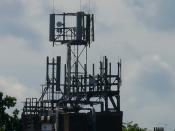GSM stands for Global System of Mobile Communications.
Global system for mobile communications is a second-generation digital technology, which was originally developed for Europe but now has in excess of 71 per cent of the world market. GSM network is a top-class standard relied on by millions of people worldwide. Some interesting statistics demonstrating the impact throughout the world are listed below:
Number of countries/areas with GSM system (as at March 2004) - 207.
GSM total subscribers (worldwide as at end of March 2004) - 1046.8 million.
GSM accounts for 73 per cent of the world's digital market and 72 per cent of the world's wireless market
Short message messaging (SMS) sent per month - 45.6 billion.
SMS forecast for 2004 - 547.5 billion.
GSM Association - total membership (as at April 2004) - 780.
Today's GSM is a hugely successful wireless technology and an unprecedented story of global achievement.
In less than ten years since the first GSM network was commercially launched in Europe, it became the world's leading and fastest growing mobile standard. GSM technology is in use by more than one in six of the world's population and it is estimated that at the end of January 2004, there were over 1 billion GSM subscribers across the world
GSM is also known as Global System for Mobile Communications, or simply Global System for Mobile. A technology started development in 1985 by a French company formerly known as Groupe Spécial Mobile. Its main competitor is CDMA, currently in use by Bell Mobility, Telus Mobility and Mobility Canada carriers.
Currently, only two main carriers in Canada are operating GSM networks. Microcell (Fido, Cityfone) and Rogers Wireless. Fido was the first carrier to start utilizing this technology, followed by Rogers Wireless mainstream around 2001. Several companies in the United...


